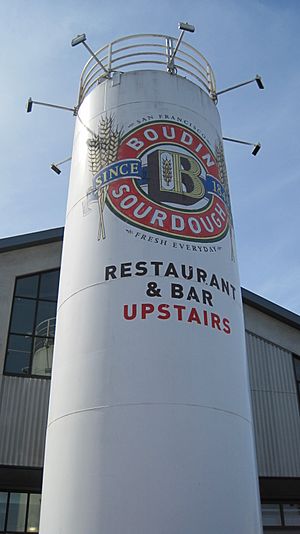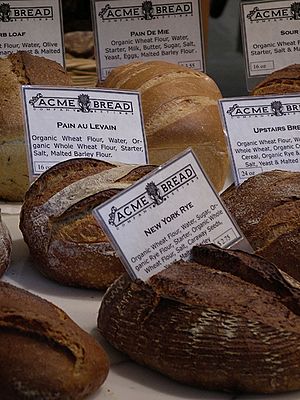History of California bread facts for kids
The history of California bread is super interesting! It all started way back during the California Gold Rush around 1849. That's when sourdough bread became famous in San Francisco. Later, in the 1980s, amazing "artisan" bakeries popped up, starting what some call the "Bread Revolution."
Contents
San Francisco's Bread Story
San Francisco has always had bakeries since the 1849 California Gold Rush. Many restaurants even bake their own bread. For a while, big companies that sold bread to grocery stores and restaurants faced tough times. But then, a new group of special "artisan" bakers came along!
Sourdough: A Gold Rush Favorite
Sourdough bread has a long history, going back to ancient Egypt. It's also popular in parts of Europe. But it really became a big deal in San Francisco during the 1849 California Gold Rush. Gold miners loved sourdough because it lasted a long time. It was also easy to make in their camps since they could get the special yeast needed.
Sourdough is made using a "starter," which is a mix of fermented flour and water. This starter contains tiny living things: special bacteria and wild yeast. In San Francisco sourdough, two main types are found: Lactobacillus sanfrancisco (a bacteria) and Candida humilis (a wild yeast). Bakers carefully kept their sourdough starters, often calling them "mother sponges."

By 1854, San Francisco had 63 bakeries! The Boudin Bakery opened in 1849. Its founder, Isidore Boudin, came from a family of bakers in France. He used French baking skills to make his sourdough. Boudin Bakery still uses the same starter from the 1800s today!
Another popular bread, Parisian, started in 1856. It supplied San Francisco's oldest restaurant, Tadich Grill, for 141 years. In Oakland, Toscana Bakery began in 1895, and Colombo in 1896. The Larraburu Brothers bakery also started in 1896. Two brothers from France opened it, bringing their special starter with them.
Changes After World War II
After World War II, many Americans started eating more packaged, sliced bread. From the 1950s to the 1980s, it was harder to find fresh bread across America. This was because bakeries became bigger and used machines more. They also used cheaper ingredients and added things to make bread last longer. Machines needed drier dough, which made bread less chewy and flavorful. Even with these changes, sourdough stayed popular in the San Francisco area.
| Bakery | Main Location | Started | Closed | Key People |
|---|---|---|---|---|
| Boudin | 399 10th Ave., San Francisco | 1849 | Still open | Isidore Boudin; Daniel Giraudo |
| Parisian* | 1995 Evans Ave., San Francisco | 1856 | August, 2005 | |
| Toscana* | 939 3rd St.; 3924 Market, Oakland | 1895 | ? | |
| Larraburu Bros.* | 365 3rd Ave., San Francisco | 1896 | May, 1976 | Larraburu Bros; Harold Paul, Sr. & Jr. |
| Colombo* | 580 Julie Ann Way, Oakland | 1896 | November, 2012 | |
| Baroni* | Baroni French Baking Co., 7801 Edgewater Dr., Oakland | Inc. 1968 | ? | George Valerio |
| Venetian | 2200 Powell St., San Francisco | ? | April, 1979 | Aldo Bertolina |
| Pisano | Main & Chestnut; Maple St. & Veterans Blvd., Redwood City | 1950 | ? | |
| *Studied by USDA in 1969 | ||||
Colombo also made sourdough rolls in Sacramento, but that bakery closed in 2003.
In 1969, scientists from the United States Department of Agriculture studied sourdough cultures from five San Francisco bakeries. They wanted to find out what made San Francisco sourdough so special. After years of work, they found the specific bacteria that gives the bread its unique flavor. They named it Lactobacillus sanfrancisco.
Some old bakeries, like Larraburu Brothers, kept the sourdough tradition alive. However, Larraburu Brothers had to close in 1976 due to financial problems. In 1971, Toscana merged with Colombo. Parisian Bakery was bought in 1982.
Steven Giraudo, an Italian baker, bought Boudin Bakery in 1941 when it was struggling. Later, his sons bought it back. The Giraudo family also bought Parisian in 1982. This bakery was then sold to the San Francisco French Bread Company, which also bought Colombo and Toscana. This company started using big, modern ovens instead of traditional ones. In 1993, the San Francisco French Bread Company was sold to a company from Illinois. This meant that three old sourdough bakeries were no longer owned locally.
In 1997, the San Francisco French Bread Company was bought by Interstate Bakeries Corporation. This company later went bankrupt and closed the Parisian bakery in 2005. They said it wasn't making enough money. At the Colombo bakery, they changed recipes and baking times, which affected the bread's quality. Before closing in 2012, Interstate was making a lot of Colombo sourdough bread and rolls. They also made snacks like Wonder Bread, Twinkies, and Ho Hos.
The old bakeries that survived became very large and used many machines. They were not small "artisan" bakeries like we think of today. The top three bakeries employed 1,000 people and made 60 million loaves of bread each year! They sold their bread in over 4,000 places in Northern California, and even in airports and supermarkets across the U.S. Boudin now has 32 stores, many of them coffee shops, including locations at Disneyland and Fisherman's Wharf.
Artisan Bread: A New Wave
The "artisan bread movement" is about going back to making smaller amounts of bread by hand. It uses some old techniques but also new ideas. Unlike the Gold Rush bakers, these new artisan bakers often use French and Italian methods to make very crusty bread.
One cool thing about new artisan breads is that they are baked with steam. This makes the crust shiny and either super crusty or chewy, while keeping the inside moist. "Rustic" breads use different flours like whole grain or rye flour. Bakers also cut designs into the top of the bread before baking. These cuts help the bread expand and create unique patterns for each bakery.
Pioneers of Artisan Bread
One of the first new artisan bakeries came from the Tassajara Zen Mountain Center near Carmel Valley. A group of monks started baking bread there in 1963. They even had a bakery in San Francisco from 1976 to 1992.
The Cheese Board Collective opened in 1967 in Berkeley. It became a worker-owned cooperative in 1971, meaning its employees owned and ran the business.
In 1970, Narsai David, a famous food writer, opened a successful restaurant called Narsai's. It became known for its amazing bread. Narsai David believed that bread baked for 24 hours tasted much better than bread baked for only three hours. This is because the longer time allowed the flavors to develop more.
Modern Artisan Bakeries Today
San Francisco Bay Area Bakeries

Acme Bread Company is a very important modern artisan bakery. Many say it started the "artisanal bread-making revolution" in the 1980s. In 1977, Steve Sullivan, a student, learned about breadmaking during a trip to Europe. He tried to make the bread he tasted in Paris. In 1979, he started baking bread for a famous restaurant called Chez Panisse. He later opened Acme with his wife, Susan. They even got their special starter from yeast found on wine grapes at his father's vineyard!
Semifreddi's Bakery is another artisan bakery in Alameda that serves the whole San Francisco Bay Area. It started in 1984. In 1987, Barbara Frainier and her husband Michael Rose took over. Barbara's brother, Tom Frainier, joined them in 1988. Tom, who had a business degree, helped Semifreddi's grow quickly. They still focus on making high-quality, European-style artisan bread and pastries.
Many other artisan bakers followed these pioneers. Some learned from places like Acme and Semifreddi's. For example, in 1989, Diane Dexter and her husband David started Metropolis Baking Company. La Farine Bakery was bought by Jeff Dodge, who had worked at Acme. Glenn Mitchell, who baked at Chez Panisse, started Grace Baking Co. in 1987. Craig Ponsford founded Artisan Breads in Sonoma, California in 1992. The Cheese Board helped start sister bakeries called Arizmendi Bakery in Oakland and San Francisco. Other well-known bakeries include The Bread Workshop and Noe Valley Bakery. In 2013, the BBC said that Tartine bakery in San Francisco made "some of the city’s best sourdough."
In the early 2000s, there were at least 65 "microbakeries" in the Bay Area. These included the original big bakeries like Boudin, Colombo, and Toscana. Together, they made about 2.4 million loaves of bread every week! Most of these new bakeries are small, local businesses. Grace Baking was bought by a Canadian company in 2002 and now sells bread nationally to stores like Safeway and Costco. Grace bakes the bread partly, and then stores finish baking it.
Even though they are competitors, these bakeries often help each other. When Ponsford opened Artisan in 1992, other bakeries like Grace, Acme, and Semifreddi's shared advice. Ponsford even became the head of the Bread Bakers Guild of America, an industry group.
You can also find artisan bread at large grocery stores like Safeway and Whole Foods. Many local restaurants also bake bread for their customers and to sell. Il Fornaio, a San Francisco-based chain, makes bread using Italian ideas and sells it in supermarkets. Another baker, Pascal Rigo, opened many restaurants and pastry shops under the name "Bay Bread." Starbucks coffee bought Bay Bread to provide baked goods for its stores and plans to expand it across the country.
A cool new trend is that some medium-sized sourdough bread companies are growing. They deliver to both small artisan markets and big chains like Safeway. An example is Sumano's Bakery in Watsonville, California. They make classic sourdough bread with simple ingredients. Another is Arcangeli Grocery Company in Pescadero, famous for its Artichoke Garlic Bread. San Luis Sourdough in San Luis Obispo started in 1983 and makes sourdough with only basic ingredients. It was even named California's Small Business of the Year in 1987.


